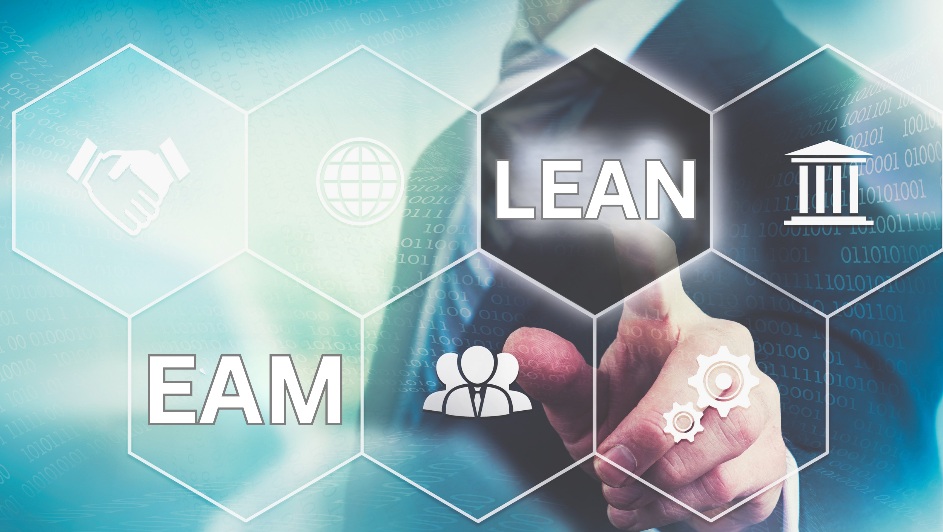Lean Advisors offers full service Lean Improvement, Continuous Improvement Consulting and Training services. We have been helping companies make sustainable performance improvements for decades. Our consultants are experienced hands-on Senior Lean experts/practitioners with extensive experience assessing and applying Lean in diverse business sectors: Lean Healthcare, Lean Finance, Lean Education, Lean Government Services, Lean Aerospace, and Lean Manufacturing, also in Food, Pharma and IT/Software.
“Lean” is a philosophy of continuous improvement. A lean organization focuses on increasing customer value, the elimination of wastes, and optimizing process operations. The key components of lean can be adapted and applied to all types of businesses and processes.
Lean Advisors provides Lean training and consulting services for organizations starting their improvement process, as well as companies that are experienced but need help to achieve a higher level of success.
Lean Transformation - 8 Days in 6 Weeks
This Healthcare organization, which recently went through a merger, completed a successful transformation using 8 days in 6 weeks. They dramatically improved their quality, cost, service and standardized the process. This transformation event has resulted in bringing the two cultures together, and staff are now supporting a common direction and strategy for moving forward.
New
Complete Remote/Virtual Training and Consulting
Plus Remote Workshops/Events Calendar
Lean Advisors now has all your Lean training and coaching options covered!
We have completed our transformation of all our on-site Lean training/consulting programs and now offer effective remote/virtual training/consulting through our Zoom or WebEx services (or through the client's preferred tool) plus Remote/Virtual Workshops. In addition, the client can enhance the above training and consulting by enrolling their staff in our interactive Online Lean Certification programs which has been utilized successfully by hundreds of our clients to increase the critical learning throughout their organizations.
Click links above for more details and contact us at [email protected] or 1.800.583.0853.
Prepare for Post Virus New World
These are very difficult times for organizations and their families. Many businesses will be negatively impacted by this Covid-19 virus and will struggle to survive. And if they survive this crisis, then they will be challenged with a whole ‘new’ world of higher customer expectations.
So, let’s be proactive and not reactive! Let’s take this time when staff are working from home to gain the critical knowledge they will need to be prepared, and support your efforts when the crisis is over.
Lean Advisors has a full interactive Online Yellow Belt Lean Program already used effectively by hundreds of companies, big and small, both manufacturing and service type, around North America. The learning/knowledge from these Online programs has trained staff on how to adapt and apply Lean to become more flexible, and be able to make them more competitive and successful.
This virus will be beat! It will change the world but you can be ready for the post viral economic demands and expectations of your customers.
Please stay safe!
News & Events
Taking Control Amid Political Uncertainty

Political negotiations and tariff uncertainties are creating anxiety for small and medium-sized businesses struggling to stay competitive and profitable. With little control or insight into future outcomes, many are forced into a difficult “wait and see” position that hinders effective planning. read more …
Turning turbulence into opportunity: maximize what you’ve got
The Canadian wood manufacturing sector faces one of the toughest economic climates we have seen in many years. Rising costs for raw materials, volatile tariffs, and unpredictable demand have created a perfect storm for wood product companies. read more …
Turbulent Times - Stay Focused

While not suggesting we completely disengage from media or political discourse, I do recommend that we concentrate on the aspects within our businesses/organizations that we can control and strive to differentiate fact from fiction when making decisions.
read more …Benefits Of Lean and Enterprise Asset Management (Lean-EAM)

The primary goal of Operations & Maintenance (O&M) is to optimize output while minimizing costs throughout the equipment’s useful life. One effective method is to employ Lean principles and implement an Enterprise Asset Management (EAM) system for equipment management.
read more …Tariffs – We Are Doomed ... Maybe Not!

Tariff discussions over the past few months are now materializing, with some officials referring to it as a ‘trade war’. While it may not be a war, it would drastically alter the North American business environment. Businesses need to be proactive. They need to look at this tariff crisis or threat of tariffs as an opportunity/motivation to make immediate changes to their operations.
read more …Municipalities and Taxes
It has become common practice for municipal taxes to increase annually, often rationalized by things like rising labour costs and inflation. Experience with government processes at various levels has taught us that a considerable amount of the activities within these processes are inefficient or 'non-value' adding. read more …
Behaviour Tied to Rewards
Communicating and driving consistent goals across a company is important. It is what should be done, except if the selected performance goals drive the wrong behaviours or replace emphasis on other important mandates of the job. Read More »
Small Businesses - Change/Improvements Made Easy
To stay competitive, small businesses need to embrace improvement, much like their larger counterparts. Yet, navigating change poses a significant challenge. With limited resources at their disposal, small businesses find investing in change particularly straining. Read More »
Streamlined Problem-Solving with the Fishbone Diagram
Utilizing a simple methodology like the Fishbone methodology can elevate your organization's quality, efficiency, and customer service to greater heights. Read More »
Lean Advisors and Healthcare Impact - Mayo Clinic
Lean and Healthcare – Powerful Combination - It WORKS - It is a remedy for healthcare organizations still struggling to do more with what they have and do it better, faster and less cost. Watch Video »



